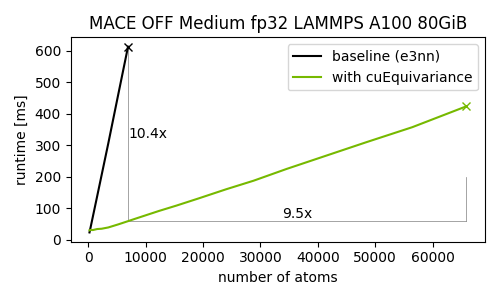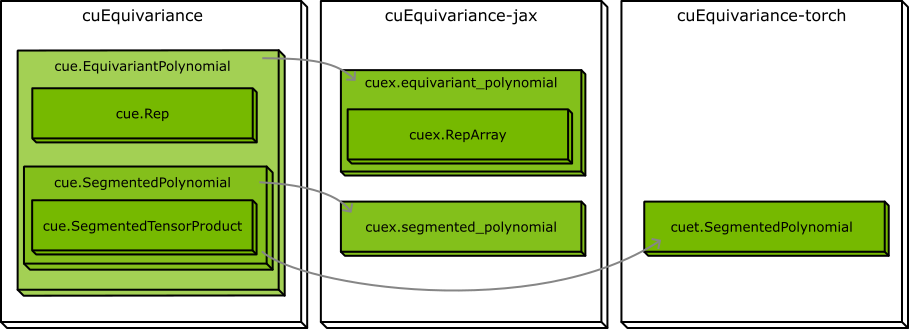NVIDIA cuEquivariance Documentation#
cuEquivariance is an NVIDIA Python library designed to facilitate the construction of high-performance geometric neural networks using segmented polynomials and triangular operations. cuEquivariance provides a comprehensive API for describing segmented polynomials made out of segmented tensor products and optimized CUDA kernels for their execution. Additionally, cuEquivariance offers bindings for both PyTorch and JAX, ensuring broad compatibility and ease of integration.
Equivariance is the mathematical formalization of the concept of “respecting symmetries.” Robust physical models exhibit equivariance with respect to rotations and translations in three-dimensional space. Artificial intelligence models that incorporate equivariance are often more data-efficient.
An introduction to group representations can be found on the page Groups and Representations.
Comparison with e3nn#
cuEquivariance provides significant performance improvements over e3nn, a popular library for equivariant neural networks. The optimized CUDA kernels and efficient segmented polynomial operations enable faster training and inference times.
The following benchmark compares cuEquivariance against e3nn on a MACE (Multi-Atomic Cluster Expansion) model:

The crosses correspond to the largest number of atoms that we managed to simulate on a single device before running out of memory.
Open Source#
The cuEquivariance frontend is open-source and available on GitHub under the Apache 2.0 license.
Installation#
The easiest way to install cuEquivariance is from PyPI using pip.
# Choose the frontend you want to use
pip install cuequivariance-jax
pip install cuequivariance-torch
pip install cuequivariance # Installs only the core non-ML components
# CUDA kernels
pip install cuequivariance-ops-torch-cu12
pip install cuequivariance-ops-jax-cu12
Requirements#
cuequivariance-ops-torch-*andcuequivariance-ops-jax-cu12packages are available for Linux x86_64/aarch64Python 3.10-3.12 is supported
PyTorch 2.4.0+ is required for torch packages
JAX 0.5.0+ is required for jax packages
Organization#
cuEquivariance is split into three packages:
import cuequivariance as cue
# All the non-ML components
import cuequivariance_jax as cuex
# For the JAX implementations
import cuequivariance_torch as cuet
# For the PyTorch implementations

Most tensor products are defined using a hierarchy of components:
cue.EquivariantPolynomial- Encapsulates thecue.Repfor each input and the outputcue.SegmentedPolynomial- Included in the EquivariantPolynomial, composed of one or several tensor productscue.SegmentedTensorProduct- Defines the specific tensor product operations
This descriptor can then be used in two ways:
In PyTorch: Create a
cuet.SegmentedPolynomialmodule for use in modelsIn JAX: Execute using
cuex.equivariant_polynomialorcuex.segmented_polynomial